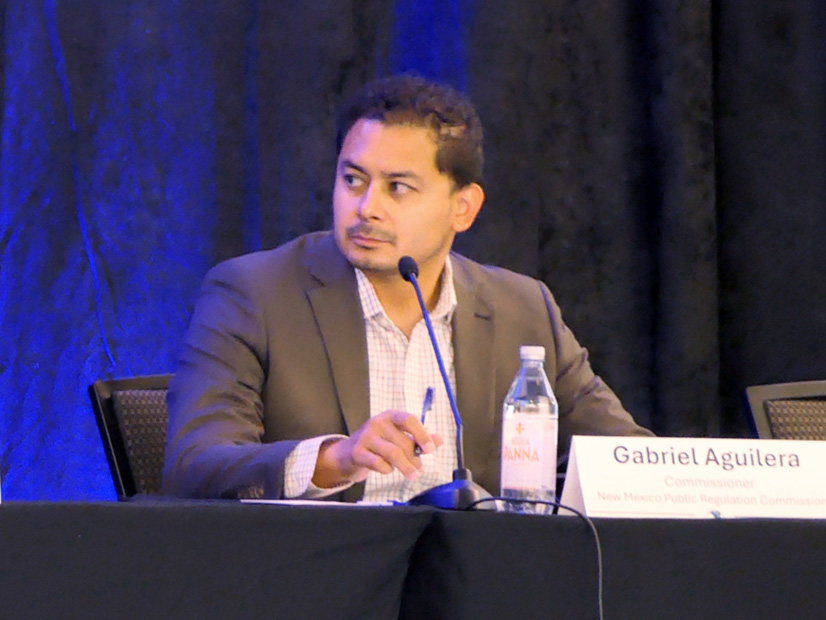As New Mexico utilities prepare to choose either CAISO’s Extended Day-Ahead Market (EDAM) or SPP’s Markets+, the state’s Public Regulation Commission has issued a set of principles intended to guide their decision.
The commission voted 3-0 on Oct. 31 to adopt the guiding principles, which emphasize customer benefits, transparency, stakeholder involvement and tracking of greenhouse gas emissions.
The guiding principles — which apply to Public Service Co. of New Mexico (PNM) and El Paso Electric Co. (EPE) — are advice rather than a mandate for steps to take in choosing a day-ahead market. And they don’t preclude PNM from making a market choice this quarter, as the utility has said it intends to do, commissioners said.
“To be clear, there are no requirements in this document,” Commissioner Gabriel Aguilera said. “And there’s nothing in this document that stops PNM from announcing a decision.”
EPE has said it hopes to make a day-ahead market decision by the third quarter of 2025.
Some parties had recommended that the commission conduct a rulemaking to establish a process and requirements for market participation. Commissioners opted not to do so, saying they didn’t want to create barriers to PNM making a day-ahead market decision this year. Rulemaking is still an option for the future, the commission said.
5 Principles
The first of the commission’s five guiding principles is that the primary driver of any market decision must be customer benefits, with economic and reliability benefits as a priority.
The commission provided a list of factors to use in determining whether a particular market decision will benefit customers. Those include the market’s expected footprint, its governance, and the cost and ease of market entry and exit.
Other factors are how transmission rights and congestion costs would be handled, and whether EDAM, Markets+ or the status quo show the best results in a cost-benefit analysis.
In the second principle, the commission said a utility’s market participation should allow for sufficient tracking and reporting of greenhouse gas emissions to demonstrate compliance with the state’s Energy Transition Act.
Thirdly, the commission said, the day-ahead market should have a fair and transparent decision-making process that “facilitates diverse and meaningful stakeholder engagement and considers stakeholder input fairly.”
A fourth principle states that a utility’s decision to join a regional market should include stakeholder input. The utility should make the study assumptions and results it is relying on available to regulators and stakeholders.
In the final principle, the commission asked utilities to provide updates on their market participation, including any major changes to the market and opportunities for stakeholder involvement.
After a utility has joined a day-ahead market, the commission would like quarterly reports for the first two years and annual reports thereafter.
Yearlong Process
Adoption of the guiding principles comes after the PRC opened a docket in August 2023 to examine factors PNM and EPE should consider when deciding whether to participate in a regional day-ahead market or RTO.
The commission held a series of workshops to discuss market participation. During an Aug. 29 workshop, The Brattle Group presented results of a study conducted for PNM and EPE, showing the utilities’ projected benefits from joining either EDAM or Markets+.
The study modeled a scenario in which three Arizona utilities — Arizona Public Service, Salt River Project and Tucson Electric Power — join Markets+.
Even with the Arizona utilities in Markets+, projected annual benefits for PNM would be $20.5 million if it joined EDAM, compared with $8 million from participating in Markets+. For EPE, projected benefits were $19.1 million a year for EDAM versus $9.1 million for Markets+. (See Brattle New Mexico Study Shows EDAM Benefits Outpacing Markets+.)
Aguilera, who led the proceeding, said the process leading to the guiding principles had been successful in creating a forum where utilities, commissioners and stakeholders could learn what each other was thinking in terms of regionalization.
“The last thing that I wanted was a surprise filing or unexpected press release from the utilities announcing they are joining ‘X’ day-ahead market,” he said.



